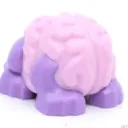Compatibility
Minecraft: Java Edition
Platforms
Supported environments
Creators
Details
GeOverhaul is currently in the early alpha stages of development, so what you can download here is more of a creative mode block and building showcase.
THAT BEING SAID...
GeOverhaul is one of the most realistic interpretations of geology ever attempted in Minecraft. The mod comes pre-loaded in with over a thousand rocks and minerals, hundreds of ores, and many more building blocks at the time of this writing, with an eventual plan to add every mineral species known to exist.
Land Generation: Worldgen is split into massive areas called provinces, ancient pieces of crust with similar rock types and species throughout. Some provinces have plate boundaries between them, creating volcanoes or mountain belts. Mountains now form exclusively in provinces called Orogenies, where the collision of two continental plates causes uplift and deformation.
Ocean Generation Oceans are also spread apart by provinces, including mid-ocean ridges, continental shelves, and hot spots. Oceans merge into continents either passively, through the sharp slopes of a continental shelf, or actively, where a massive trench will form underneath the opposing continent, spawning a volcanic arc of islands. Geothermal activity is common in the oceans, with biomes of hydrothermal vents forming, or an entire island of hot spots may form.
Ore Generation Minerals now generate solely in rocks which are able to host them. Coal can be found as large layers and veins in mountains and swamps, and has been split up into three varieties based on their effectiveness in furnaces, between Lignite, Bitumen (Vanilla Coal) and Anthracite. Iron has become even more common, since iron is one of the most common elements in the crust. Gold has become rarer, now being found rarely in sandbanks by rivers, the same way that prospectors found gold in 1849 in San Francisco. Gold can also be found in large veins of quartz in mountains. Copper is found in massive amounts along plate boundaries, as porphyry granite containing copper likes to intrude along weak points between plates, but copper in other forms can be found in most rocks. Malachite likes to form in limestone, for example. Diamonds are now found exclusively in Kimberlite, a rare igneous rock that shoots up through the mantle to reach the crust in small but very prosperous amounts. Lapis Lazuli is now found as a rock type, as it's always been a metamorphic rock, not an ore. Redstone remains unchanged.
The Field Notebook One of my favorite ideas in the mod is the Field Notebook, the in-game Wiki. If you have a cool rock or mineral species that you'd like to show off, you can post it in the #pics section of the Discord, and if it meets the criteria, you could have your own rock or mineral in the mod.
Specific Details
New Sedimentary Rocks: Limestone (15 kinds), Dolostone (6 kinds), Shale (9 kinds), Mudstone (6 kinds), Siltstone (3 kinds), Sandstone (13 kinds), conglomerate/breccia (10 kinds), Chert/Chalcedony (24 kinds), Bauxite (4 kinds), Argillite (3 kinds), Diamictite (3 kinds).
New Metamorphic Rocks: Marble (8 kinds), Slate (2 kinds), Phyllite (3 kinds), Schist (4 kinds), Gneiss (6 kinds), Mylonites (4 kinds), Eclogite (4 kinds).
New Igneous Rocks: Granite (20 kinds), Basalt (7 kinds), Tuff (5 kinds), Gabbro (4 kinds), Syenite (6 kinds), Rhyolite (5 kinds).
This is not a comprehensive list by any measure, I'll let you discover the rest for yourself.



